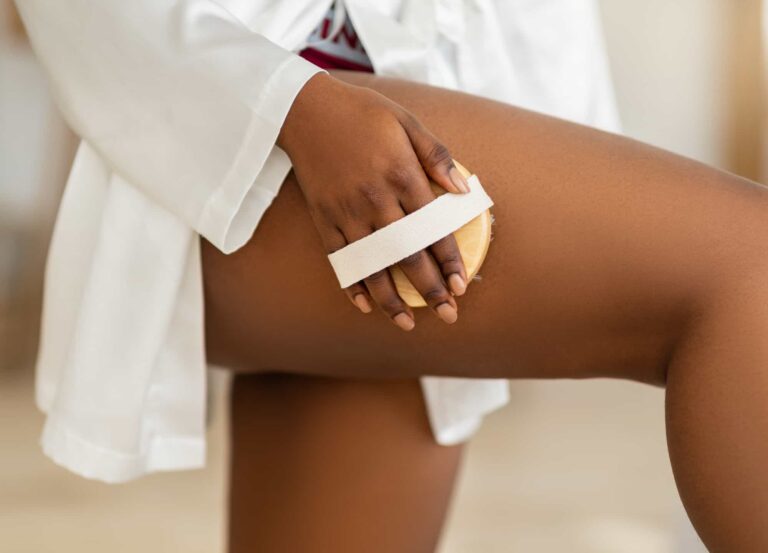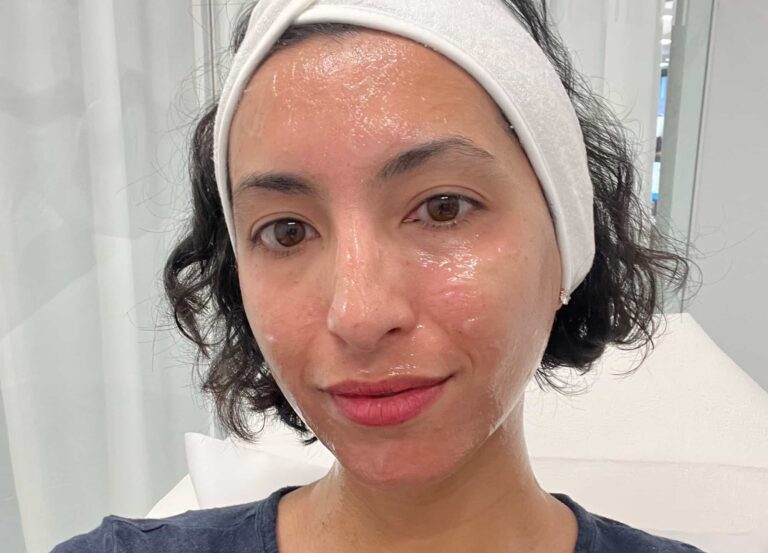No matter whether you’re looking to eliminate unwanted facial fuzz or score a completely bare bikini line, there’s no shortage of hair removal methods to choose from. These vary greatly across the board, working in a variety of different ways and delivering equally varied results (at all kinds of price points). So consider this a one-stop hair removal cheat sheet, a detailed breakdown of seven of the most popular options out there, from long-lasting hair removal options to quick fixes. Keep reading to determine which M.O. is right for you, then get ready to sport seriously smooth skin.
Shaving
How it works: A razor blade cuts off excess hair growing above the surface of the skin.
Cost: Shaving is very inexpensive. You can easily find a quality razor plus a shaving cream (essential for providing lubrication to help the blade glide smoothly and minimize the likelihood of nicks, irritation, and razor burn) for less than $20. Our current favorite dream team: Billie The Razor ($9) and Eos Shave Cream ($4).
Where to try it: “Shaving can be performed on all body parts that are hair-bearing, just take extra care when shaving the genitalia,” explains Dr. Manish Shah, a board-certified plastic surgeon in Denver. Women should also be cautious when shaving their faces, adds Dr. Michele S. Green, a board-certified dermatologist in New York City who recommends dermaplaning instead. The latter uses a finer blade that’s better for delicate facial skin (though it will take off peach fuzz only, not coarse hair) and exfoliates by removing dead cells along with the hairs.
How long results last: Since you’re removing just the part of the hair that’s sticking out above the skin, results will last only as long as it takes for that hair to start growing again, notes Dr. Shah. This depends on the individual, but most people will notice at least some stubble reappearing within a few days.
Safe to DIY? Yes, very.
Safe for all hair colors and skin tones? Yes, although it’s worth noting that African Americans have a higher incidence of ingrown hairs after shaving because of the curly nature of their facial and body hairs, points out Dr. Shah.
Pros: It’s easy for anyone to do, can be done anywhere on the body (legs, underarms, bikini line) and it’s very cost-effective and safe for all hair colors and skin tones.
Cons: You’ll have to shave pretty frequently in order to maintain your desired level of fuzz-free skin.
OTC depilatory cream
How it works: This cream is applied to the skin’s surface to remove unwanted hair, where it works via a method known as keratinolysis. “The chemicals in the cream dissolve the keratin in the exposed hairs, which are then wiped away,” explains Dr. Shah.
Cost: It’s inexpensive, generally under $10.
Where to try it: Depilatory creams can be quite strong, so consider reserving these for body hair removal on less sensitive, larger areas, such as arms or legs. “If you’re going to use one on your face, be sure to choose a gentler product that’s been specifically formulated for this purpose in order to minimize the likelihood of irritation,” advises Dr. Green. One that fits the bill: Nair Hair Remover Face Cream ($4).
How long results last: Anywhere from one to three weeks.
Safe to DIY? Yes
Safe for all hair colors and skin tones? Yes, but be careful if you have sensitive skin. If you want to play it extra safe, Dr. Green suggests applying the cream for less time than directed. For example, if the total leave-on time is 15 minutes, leave it on for just five minutes, wipe off, then repeat this process two more times. Shorter amounts of contact time and removing it in between can help reduce potential side effects, such as sensitivity. (You can also perform a DIY patch test prior to use. Apply a small amount of the product on your inner forearm and monitor the area for any signs of skin reaction for 24 hours before using it.)
Pros: It is inexpensive and easy to use.
Cons: While these creams are generally well-tolerated, allergic reactions and sensitivity are possible. Results aren’t particularly long-lasting.
Related: The Best Ways to Remove Your Unwanted Facial Hair At Home
Waxing
How it works: Warm, melted wax is spread onto the skin; as it cools, it hardens and traps the hair. “The wax is then quickly pulled off, to yank out the hair shaft and follicle,” explains Dr. Shah.
Cost: This varies based on where you live, whether you see a pro or DIY, and which area your waxing. Salon waxing can range anywhere from $10–$15 for smaller areas, like the eyebrows or upper lip, to upwards of $250 for full body waxing, says Dr. Shah. At-home waxing products, such as kits and wax strips, can cost anywhere from $5 to $50 and up.
Where to try it: It can be done anywhere, though Dr. Shah says it’s best on areas where the skin is flat, such as the arms, legs, and back, or upper lip and brows (as opposed to spots like the armpits), so that wax removal can be performed cleanly.
How long results last: Because the hair is being pulled out at the root, results last about three to four weeks, says Dr. Green.
Safe to DIY? Yes, but proceed with caution. Choose a product specifically made for the area you’re waxing and read (and follow) directions exactly. If you are going the DIY route, we like the Flamingo Head to Toe Wax Kit ($19), which has everything you need to wax both face and body.
Safe for all hair colors and skin tones? Yes, although those with sensitive skin may be more likely to experience irritation.
Pros: Waxing works well on a variety of areas, and there’s a range of both at-home and in-salon options, at all price points. Results are longer-lasting than shaving, and with continued waxing, hairs tend to grow in a bit softer and more slowly, adds Dr. Shah.
Cons: It can be a bit uncomfortable—particularly on sensitive parts of the body, such as the bikini area—and there’s also a likelihood of irritation and even burning if not done properly, says Dr. Green.
Prescription hair removal cream
How it works: Currently, there is one brand of cream on the market, Vaniqa. “It uses eflornithine hydrochloride, which targets the hair follicle to prevent hairs from entering the growth cycle,” explains Dr. Green.
Cost: The price is about $200, but Dr. Green notes that insurance may cover it in certain cases.
Where to try it: If you’re looking for the best hair removal for face, this may be it; these are intended for use on the face only.
How long results last: Vaniqa won’t remove hair but it will slow down growth, causing the hairs to become lighter and finer over time, says Dr. Shah. How long it takes to see these results varies from person to person, though it’s usually a few weeks.
Safe to DIY? Yes, you can apply the cream yourself, but they’re available by prescription only.
Safe for all hair colors and skin tones? Yes, although it’s worth noting that pregnant women may want to hold off. The safety of these creams in pregnancy has not yet been established.
Pros: The cream is an easy way to target unwanted facial hair and works for all skin types and hair colors.
Cons: It’s pricey; works only for the face; and, ultimately, isn’t actually removing hair.
Electrolysis
How it works: An epilator device emits shortwave radio frequencies or an electric current into the follicle. “This damages it, to prevent future hair growth while also causing existing hairs to fall out,” Dr. Green explains.
Cost: Prices can vary anywhere from $30 to more than $100 per treatment, says Dr. Shah. Keep in mind that you’ll need multiple sessions—usually four to six, spread out every six to eight weeks—to see complete results, says Dr. Green. RealSelf members say the average cost for treatment is $425.
Where to try it: Electrolysis can be done safely and effectively on all areas of the face and body. It can be painful, so sometimes a topical numbing cream is used on sensitive spots, such as the bikini line.
How long results last: According to the U.S. Food and Drug Administration (FDA), electrolysis is the only permanent hair removal method. Along with laser hair removal, this is one of the most long-lasting hair removal methods there is, says Dr. Green.
Safe to DIY? While there are at-home electrolysis devices out there, both experts agree that the results these tools deliver are inferior and that it’s best to see a professional aesthetician trained and certified in electrolysis.
Safe for all hair colors and skin tones? Yes.
Pros: It produces very long-lasting results and can be done everywhere on everyone. Unlike with laser hair removal, this is a good option even for lighter hair.
Cons: Multiple sessions are needed, and it can be costly and painful.
Related: Should You Try At-Home Laser Hair Removal?
At-home energy-based devices
How they work: “These devices use IPL, intense pulsed light. A bright light is quickly flashed onto the area being treated. The light is filtered so that a specific wavelength hits the pigment in the hairs, creating heat and destroying the hair follicle,” explains Dr. Shah.
Cost: This is one instance where you get what you pay for. While Dr. Shah says you can find devices costing anywhere from $100 to more than $400, the quality is directly correlated with price. We’ve had good results with the Luma Rx Full Body IPL Skin Beauty System ($449).
Where to try it: Skip the genitals as well as larger, hard-to-reach spots, like your back. Sticking with smaller areas—bikini line, upper lip, toes—is your best bet.
How long results last: These won’t deliver permanent results, though with repeated use (most devices are meant to be used every two weeks), you can expect a permanent reduction in hair growth.
Safe to DIY? Yes, but it’s very important to proceed with extreme caution, says Dr. Green.
Safe for all hair colors and skin tones? Nope. These are a major no-no for anyone with dark skin. These devices can’t differentiate between the pigment in the hair and pigment in the skin, increasing the risk of burns and scarring, warns Dr. Shah. (He also advises that even fair-skinned individuals avoid using these during the summer, since the same issue can arise with tanned skin.) Similarly, the devices won’t work on light hair. The best candidate is someone with pale skin and dark hair.
Pros: Discomfort is generally minimal, and these devices can be used in the comfort of your own home. With repeated use, results can be effective and long-lasting.
Cons: They won’t work on dark skin and/or light hair, come with the risk of user error, and are costly.
In-office laser hair removal
How it works: These professional devices work similarly to their less intense counterpart, IPL. The laser energy targets the melanin (pigment) in the hair follicle. As it converts from light to heat, the follicle is damaged and growth restricted.
Cost: Again, prices run the gamut, depending both on where you live and the area you’re treating. Dr. Green says you can expect to shell out anywhere from $200 to $600 per treatment; RealSelf members say it costs an average of $875. And keep in mind that you will need multiple treatments—anywhere from six to eight, spaced a few weeks apart—in order to achieve the desired results. The laser gets only the hairs that are in the growth phase of the hair cycle.
Where to try it: It can be done anywhere on the body or face.
How long results last: This won’t permanently remove hair, but it will permanently reduce it. A complete cycle of treatments can remove anywhere from 70% to 90% of hair in a given area. You’ll need to plan on at least an annual touch-up in order to maintain these results, though the good news is, any hair that does grow in will usually be much finer. Point being, it’s another good choice if you are looking for a more long lasting hair removal method.
Safe to DIY? No. Don’t mistake in-office laser devices with the weaker, at-home IPL tools meant for consumer use. Lasers are for pros only.
Safe for all hair colors and skin tones? Once upon a time, not so long ago, the answer was no, but recent advancements in technology have made laser hair removal an option for people with all skin tones. Newer lasers, such as the Nd:YAG laser, have a longer wavelength that bypasses the melanin-dense part of the skin, making it safe for even the two darkest skin types, Fitzpatrick V and VI. That being said, dark skin is still at higher risk of burning and hyperpigmentation, making it all the more paramount that your provider is licensed and experienced… and using the right laser. And despite many new innovations, laser hair removal is still likely to be ineffective for those with lighter hair.
Pros: This offers permanent hair reduction and can be done on any area of the body or face.
Cons: Multiple treatments are needed, it’s costly and not a good option for those with light hair, and it can be mildly uncomfortable (like rubber bands snapping against the skin).











